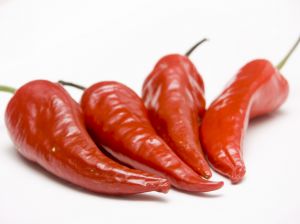The ability to selectively switch off pain whilst leaving other nerve pathways unaffected has been a holy grail of anaesthesia for decades. But now researchers in the US have cracked the problem, with the help of a redundant anaesthetic agent and the juice of a chilli.
 Writing in this week's Nature, Alexander Binshtok and his colleagues from Harvard Medical School have found that the combination of capsaicin, the chemical that makes chillis hot, together with a local anaesthetic derivative called QX-314 that doesn't normally penetrate nerve cells, can render rats insensitive only to pain. The team injected the spicy anaesthetic mixture into the animals' hind limbs, adjacent to their sciatic nerves. The animals continued to walk around normally, but showed a dramatically reduced sensitivity to painful and thermal stimuli. Neither agent injected on its own reproduced the effect, so what was the basis of this pain-killing combination?
Writing in this week's Nature, Alexander Binshtok and his colleagues from Harvard Medical School have found that the combination of capsaicin, the chemical that makes chillis hot, together with a local anaesthetic derivative called QX-314 that doesn't normally penetrate nerve cells, can render rats insensitive only to pain. The team injected the spicy anaesthetic mixture into the animals' hind limbs, adjacent to their sciatic nerves. The animals continued to walk around normally, but showed a dramatically reduced sensitivity to painful and thermal stimuli. Neither agent injected on its own reproduced the effect, so what was the basis of this pain-killing combination?
It turns out that QX-314 does not normally work as a local anaesthetic because the molecule has a permanent positive charge. This prevents it from penetrating the oily membranes of nerve cells, which it needs to do in order to block pores in the membrane that are essential for nerve excitation, and this can only occur from inside the cell. But adding capsaicin provides the anaesthetic agent with an alternative route into the cell by opening a channel in the membrane called TRPV1. So when the capsaicin prises open the channel, the QX-314 slips inside. And because TRPV1 is only found on nerve cells that convey pain signals, only pain-bearing fibres are inactivated. The team are confident that the discovery will make a major impact on surgical and post-op anaesthesia.
"Eventually the method could completely transform analgesia, allowing patients to remain fully alert without experiencing pain or paralysis," says co-discoverer Professor Clifford Woolf.










Comments
Add a comment